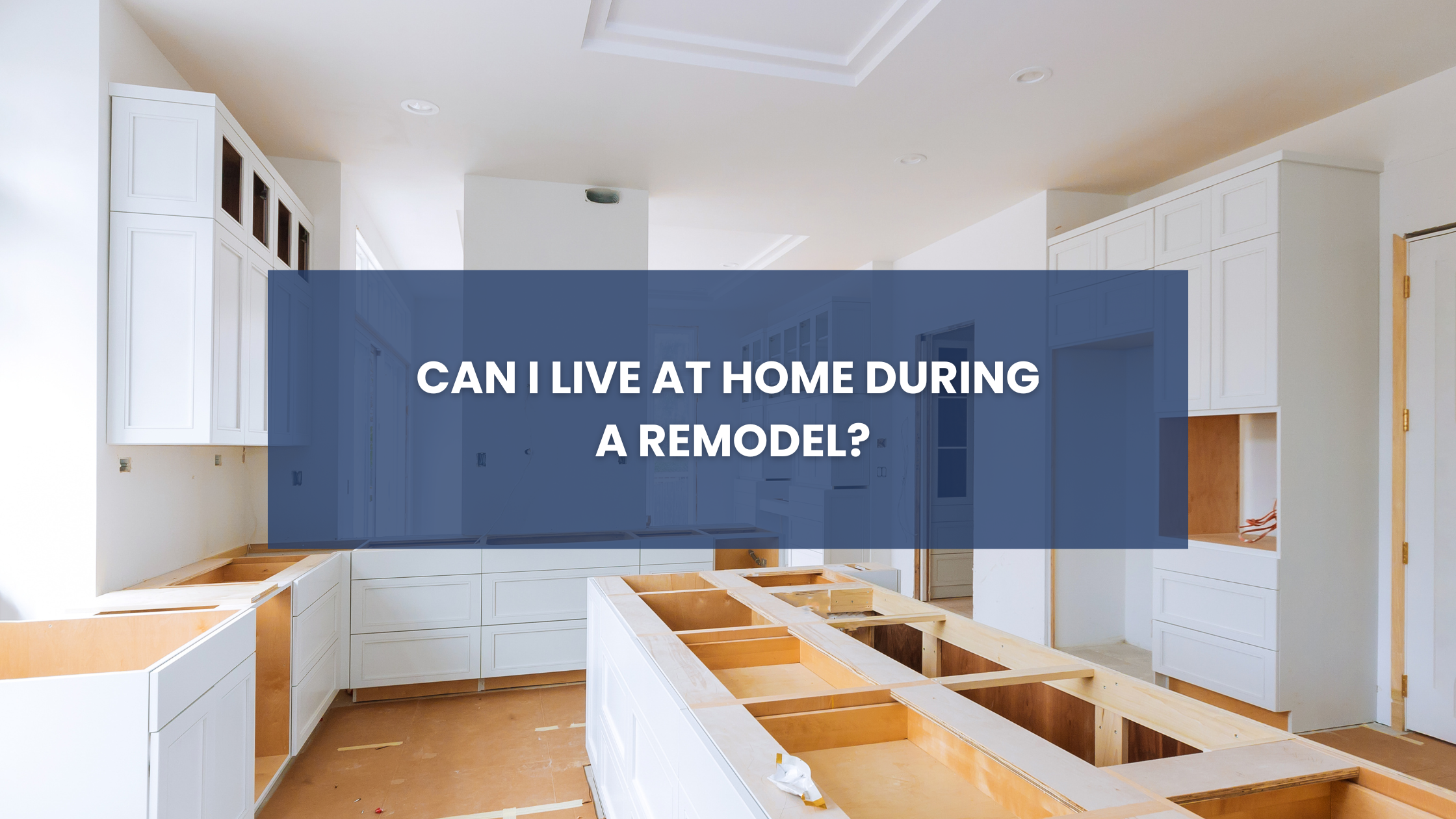Can I Live at Home During a Remodel?

If you’re planning a remodel, you’ve probably asked yourself: Can we stay here while this is happening? It’s a big question—and the answer isn’t always straightforward. The idea of living through construction can feel overwhelming, especially when your kitchen, bathroom, or main living areas are part of the project.
At Thayer Design Build, we’ve worked with many homeowners in Corvallis, Albany, Philomath and the surrounding areas who have chosen to remain at home during their remodel—and others who’ve decided to temporarily move out. Both paths can work. It all depends on the scope of the project, your comfort level, and the support you have along the way.
In this blog, we’ll walk you through what it’s really like to live at home during a renovation. You’ll learn:
- When staying put might be a good fit
- When it’s better to relocate
- How to make the experience more manageable if you choose to stay
- How our team helps make living at home during construction more predictable, safe, and (dare we say) comfortable
Let’s take a closer look at what to consider—and how to make the right choice for your household.
Can You Stay? What to Consider

Living at home during a remodel is possible—but it’s not always practical. The best way to determine if it’s the right choice for your household is to take a close look at a few key factors:
Scope of Work
The bigger the project, the more disruptive it will be. A home remodel often involves demolition, framing, and utility work that touches multiple areas at once—making day-to-day living a challenge. On the other hand, a single-room remodel (like a bathroom or kitchen refresh) might be easier to live through if you can carve out alternate spaces for cooking or bathing.
Also, consider what materials are being replaced. For example, replacing all your flooring at once may require moving furniture out and finding temporary shelter, even if the rest of your home isn’t under construction.
Timeline and Daily Disruptions
Even the most thoughtfully managed jobsite comes with noise and dust. Ask yourself: How will this impact our household schedule? Kids’ routines? Pets? If you’re someone who needs peace and quiet during the day—or if you have little ones on a nap schedule—this could be a dealbreaker.
We’ll always share a clear project schedule with you so you can anticipate when the most disruptive phases (like demolition) will occur. In some cases, clients choose to stay for most of the remodel and simply leave for a few key weeks.
Access to Essential Spaces
One of the biggest questions is whether you’ll still be able to use critical parts of your home—like the kitchen, bathroom, or main entry. If the only full bathroom is being remodeled, or if there’s no practical way to enter and exit safely each day, staying might not be realistic.
Our team will help you evaluate what access can be maintained and where temporary solutions can be put in place (more on that soon).
Your Family and Pets
Some families are unfazed by construction and find creative ways to work around the chaos. Others—especially those with young kids, pets, or elderly family members—might find the disruption too stressful. Remodeling can be an exciting process, but it’s also messy and unpredictable at times. Knowing your household’s threshold for that kind of temporary upheaval is key. We recommend checking out two of our blogs for a comprehensive list of considerations for navigating a remodel with kids or pets.
Pros and Cons of Living at Home During a Remodel

Choosing to live at home during your remodel is a highly personal decision—and like most big decisions, it comes with trade-offs. Some homeowners appreciate staying close to the action, while others prefer to step away entirely. Here’s a balanced look at the pros and cons to help you make the best choice for your situation.
Pros of Living at Home During a Remodel
- You save on temporary lodging.
One of the most obvious benefits is financial—if you can comfortably stay at home, you won’t need to pay for a rental, hotel, or Airbnb. Those savings can be reinvested in your project (hello, splurge-worthy fixtures!). - You’re nearby to ask questions and make decisions.
Remodeling is a collaborative process. Staying on-site allows us to check in on progress, answer quick questions in person, and feel more involved. We love working closely with our clients—it’s part of what makes the Thayer experience feel like a true partnership. - It helps maintain consistency for children and pets.
For families with young kids or pets, keeping routines as normal as possible can be grounding. Staying in your home—despite the dust and noise—might be less disruptive than moving out entirely.
Cons of Living at Home During a Remodel
- It can get loud at certain points of the project.
Power tools, deliveries, hammering, and team conversations are all part of a typical workday on-site. Even with good communication around schedules, noise is unavoidable during active construction. - Dust happens.
We use containment systems, plastic barriers, and HEPA-filtered air scrubbers to minimize dust—but some still finds its way into adjacent spaces. If you have allergies or are particularly sensitive to dust, this is an important factor to consider. - Privacy is limited.
Expect early arrivals and a consistent crew presence during construction. While our team is always respectful of your space and does their best to ensure your privacy, your home becomes a shared environment for the duration of the project—which may feel invasive for some households
When It’s Not a Good Idea to Stay During a Remodel

While many homeowners can—and do—successfully stay in their homes during a remodel, there are certain situations where it’s simply not advisable. If any of the following apply to your project, temporary relocation may be the safer, more comfortable choice.
Remodels of Essential Spaces
If your project involves tearing down and rebuilding key parts of your home—like your only kitchen or bathroom—it may not be possible to stay, at least during certain phases of construction. Even with creative workarounds, there’s only so much you can do without running water, cooking facilities, or safe access to basic necessities.
Hazardous Materials
If your home was built before the 1990s, there’s a chance that asbestos, lead paint (in 1978, it was outlawed), or other hazardous materials could be present. In these cases, certified abatement is required—and for safety reasons, this can be a good time to leave your home. However, it’s not always essential, as containment measures are always put in place.
Safety Risks for Children or Pets
Construction zones come with sharp tools, exposed wires, open framing, and other potential hazards. For families with curious toddlers or free-roaming pets, the risk of injury may be too high to manage. In these cases, we often recommend relocating or arranging a temporary living space away from the main work areas.
No Clear Separation Between Living and Work Areas
If the layout of your home doesn’t allow for any true separation between the construction zone and your living space, it can be nearly impossible to maintain comfort—or sanity. When dust, noise, and foot traffic bleed into every room, the stress of staying can outweigh the benefits.
Tips for Staying at Home During Construction

If you’ve weighed the pros and cons and decided to live at home during your remodel, good planning can go a long way in making the experience smoother. Here are some tried-and-true tips to help you stay comfortable and reduce stress while work is underway:
Set Up a Temporary Kitchen or Bathroom
If your kitchen is out of commission, carving out a makeshift meal prep area is essential. A folding table, microwave, mini fridge, and coffee maker can go a surprisingly long way. For bathroom remodels, consider access to a guest bathroom—or even renting a temporary outdoor unit.
Need ideas? We’ve got you covered. Read our blog on how to set up a temporary kitchen during your remodel.
Establish Clear Communication with Your Contractor
Daily disruptions are easier to manage when you know what to expect. At Thayer Design Build, we provide a clear timeline and consistent updates so you’re never in the dark about what’s happening. If you’re planning to stay, we’ll help you understand exactly when things will get loud, messy, or require adjusted access.
Create a “Quiet Zone” or Private Suite
If possible, designate an area of the home that’s off-limits to construction. A closed-off hallway or basement can offer a much-needed escape from the hustle and bustle. We’ll work with you to define and preserve that space whenever possible.
Get Creative with Temporary Housing
Some clients choose to stay in an RV parked on their property, giving them proximity without the dust. Others take a short vacation during the more disruptive phases (like demo and wood floor refinishing). If you’re open to a short-term change of scenery, even a week away can make a big difference.
How Thayer Design Build Supports You Through It

Successfully living at home during a remodel takes clear communication, thoughtful planning, and a team that respects your daily life as much as your design goals. Here’s how we help make that possible:
Clear Timeline Planning
Before construction begins, we’ll walk you through the project schedule in detail—highlighting the most disruptive phases and helping you plan around them. Whether that means finding the right time to take a vacation or to be extra cautious with children around the jobsite, we’ll support you in making the best decision for your family.
Ongoing Communication
Our team keeps you informed every step of the way. Expect regular check-ins, prompt responses to your questions, and a proactive approach to any changes or challenges that may arise. When you stay at home during a remodel, those updates become even more essential, and we take that responsibility seriously.
Respectful Jobsite Etiquette
We treat your home as if it were our own. That means showing up on time, keeping the workspace tidy, minimizing dust and debris with proper containment systems, and maintaining professional conduct at all times. Your privacy and comfort matter—especially when you’re living in the space we’re remodeling.
Temporary Accommodations When You Need Them
In some cases, staying put isn’t the best fit—and we’re here for that too. Thayer clients have access to the Cloverland Guesthouse, a fully stocked short-term rental in Corvallis designed for comfort and convenience during your remodel. It’s just one more way we help make the experience more manageable.
Is Living at Home During a Remodel Right for You?

Living at home during a remodel is absolutely possible—but it’s not the right fit for everyone or every project. The key is understanding what to expect, making thoughtful plans, and partnering with a team who prioritizes your comfort as much as your home’s transformation.
At Thayer Design Build, we’re here to guide you through every step—from evaluating whether staying home is realistic, to helping you prepare for what’s ahead. Whether you choose to stay or step away, we’ll create a plan that supports your lifestyle and keeps the project on track.
Have questions about what it might look like for your home?
Let’s talk—we would be happy to walk you through the practicalities and help you decide what makes the most sense for your family.